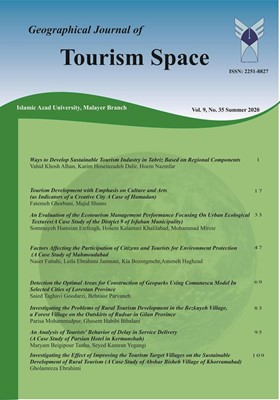بررسی رفتار گردشگران از تأخیر در ارایه خدمات (مورد مطالعه: هتل پارسیان کرمانشاه)
الموضوعات :
مریم بیگ پور تنها
1
![]() ,
سید کامران یگانگی
2
,
سید کامران یگانگی
2
![]()
1 - دانشجو دوره دکتری ، گروه مدیریت بازار یابی ، دانشگاه آزاد اسلامی همدان ، همدان ؛ ایران
2 - گروه مهندسی صنایع ؛ دانشگاه آزاد اسلامی واحد زنجان
الکلمات المفتاحية: عدم اطمینان, تمایل به خرید, تأخیر در خدمات دهی, عصبانیت, بازاریابی دهان به دهان منفی,
ملخص المقالة :
هدف بررسی رفتار مشتریان متأثر از تأخیر در خدمات میباشد. تعداد فرضیات مورد آزمون در این پژوهش، 9 فرضیه میباشد. روش این پژوهش از نظر بررسی متغیرها از نوع توصیفی – پیمایشی و از نظرنوع هدف، کاربردی میباشد. جامعه آماری این پژوهش هتل پارسیان کرمانشاه میباشند. روش نمونهگیری در این پژوهش تصادفی ساده بود که تعداد 384 نفر به عنوان نمونه از طریق فرمول کوکران، برای جمعآوری دادهها انتخاب شدند. در این پژوهش از پرسشنامه به عنوان ابزار تحقیق استفاده شد که روایی و پایایی آن نیز مورد اعتبارسازی قرار گرفت. برای تجزیه تحلیل دادهها و آزمون فرضیات، از روش تحلیل عاملی تأییدی با استفاده از نرم افزار معادلات ساختاری آموس نسخهی 22 استفاده شده است. با توجه به نتایج پژوهش، تأخیر در خدمات دهی بر عصبانیت و عدم اطمینان مشتریان تأثیر مثبت و بر قابلیت پذیرش آنها تأثیر منفی دارد. همچنین عصبانیت و عدم اطمینان بر تمایل به خرید تأثیر منفی و بر بازاریابی دهان به دهان منفی تأثیر مثبت دارند. در پایان قابلیت پذیرش نیز بر تمایل به خرید تأثیر مثبت ولی بر تمایل به بازاریابی دهان به دهان منفی تأثیر منفی دارد.
_||_


